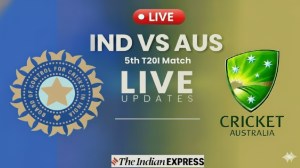Chalo America
BARELY three days before Prime Minister Manmohan Singh landed in Washington, there were two simultaneous events at the Carnegie Endowment fo...

BARELY three days before Prime Minister Manmohan Singh landed in Washington, there were two simultaneous events at the Carnegie Endowment for International Peace, a leading American think tank. One was a discussion on ‘‘Rising US-China Frictions’’, trying to make sense of the rapidly growing tensions in Sino-American relations during the second George W. Bush Administration. The other was the release of a new report by Ashley Tellis, an India-born strategic analyst, India as a New Global Power: An Action Agenda for the United States.
And thereby hangs the tale of Singh’s engagement with President Bush. It is a tale of two rising powers in Asia and the response of the sole superpower to the unfolding power shift in the international system.
While the Indian media is obsessed with specific outcomes from the Singh-Bush meeting, such as agreements on civilian nuclear energy, cooperation in high technology areas, and American support for India’s permanent membership of the United Nations Security Council, the talks signify a lot more.
The Singh-Bush parleys on Monday, July 18, are about the new dynamism in the triangular relations between New Delhi, Washington and Beijing. The results from these talks will constitute an important step in the long process to establish a new balance of power in Asia and the world.
By any measure, Singh’s visit to the United States is a rare one, when considered either in the context of American diplomatic practice or the history of Indo-US relations. Not since the arrival of Chinese leader Deng Xiaoping to the US in January 1979, has an administration so chosen to hype a foreign dignitary’s visit.
Deng, then by designation a mere vice-premier, had barely begun to pull China out of the morass of Mao’s Cultural Revolution. His visit marked the consolidation of the Sino-US partnership at a time when there was a revival of cold war between Washington and Moscow.
China was by no means a strong nation then, having just begun its economic reforms. It was a pygmy in comparison to America and Russia. But it was China’s potential to alter the global power calculus that encouraged Washington to shower attention on Deng.
SIMILARLY while India’s weight in the world system is growing, it is much weaker than either the US or China. But it is the prospect that India is emerging as the ‘‘swing state’’ in the global balance of power that is shaping Singh’s visit to Washington.
It is the Bush administration that has taken the initiative on Singh’s visit. Three months ago, President Bush dispatched the new secretary of state, Condoleezza Rice, to Delhi to lay out a fresh template for Indo-US relations. External Affairs Minister Natwar Singh was in Washington three weeks later to have it confirmed that the US meant what it was saying.
| While the Indian media is obsessed with specific outcomes from the Singh-Bush meeting, such as the Security Council expansion, the talks signify much more: the new triangular relations between India, China and the US |
The essence of Bush’s message is that America wants to assist India realise its aspirations to become a global power. Why would one nation want to build up another, sceptics in India ask. After all, they rightly point out, international relations are not based on charity or altruism.
The answer is quite simple. As China rises like a colossus, the US would like to see a stronger India that can contribute to peace and stablity in Asia. Not very different from what the US did with China in balancing the Soviet Union in the 1970s and 1980s.
There is one big difference between then and now. The Soviet Union was not part of the global economic system, by conscious choice. But Deng’s policies have resulted in integrating China with the world economy. China is all set to become the world’s second largest economy and one day, in the not too distant future, reach parity with the United States.
In this context, the way America balances China will be very different from the way it isolated and contained the Soviet Union. Senior US officials visiting New Delhi in recent weeks have repeatedly asserted Washington does not seek a confrontation with China. In statements in the past few months, US officials have said they see the rise of India as a democratic power as a stabilising one for the international system.
But they add they are not sure the rise of China will indeed be peaceful. The US says it is looking for stronger relationships with other Asian powers like India to ensure the rise of China will be peaceful rather than violent.
THE Left and many others in the country are worried India might be seduced into becoming a frontline state against China. Those who make this argument find it difficult to adapt to the notion of a balance of power, which is not about identifying new enemies. It is about ensuring that power capabilities in the world are in an equilibrium that prevents any one of the major powers from experimenting with aggrandisement.
India is fully conscious that the density of the Sino-US relationship is much thicker today than that between either New Delhi and Washington or New Delhi and Beijing. India’s total commerce with the world is smaller than the Chinese trade surplus — $ 160 billion in 2004 — with the United States.
Further, India’s relations with China have never been as good as they are today. For the first time in decades, India and China have a rapidly growing economic relationship and are making progress in resolving their political disputes.
India is aware it has begun to matter in world politics in a manner it did not in the past. New Delhi knows the world is big enough to accommodate a rising India and a rising China. Unlike some in India, the government has no reason to be apologetic about its growing capabilities.
India’s strategy towards the US and China will not be dissimilar to that followed by Deng towards America and the Soviet Union in the 1980s. While deepening relations with Washington, Deng also began normalising bilateral ties with Moscow. Deng was playing a balancing game, at the end of which China was much stronger than before.
In one line, that’s Manmohan Singh’s agenda in Washington.



- 01
- 02
- 03
- 04
- 05



























